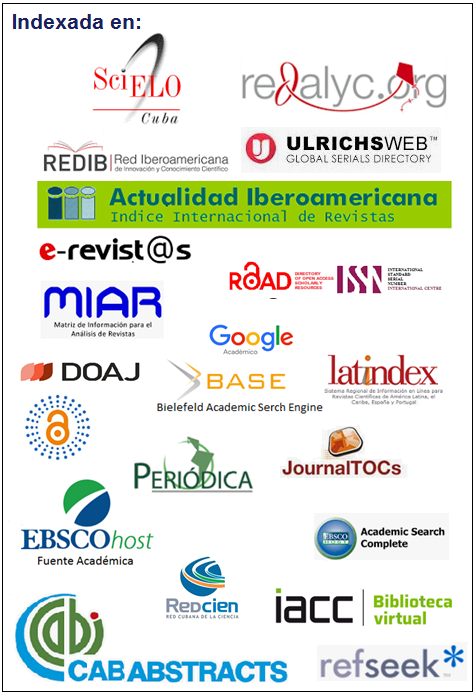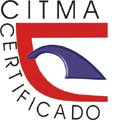Assessment of indicators validity conditioning soils liquefaction
Keywords:
validity, indicator system, soil licuefaction, Kendall coefficientAbstract
Mathematical validation is an ideal tool for studying scientific facts. The liquefaction of soils is one of the most catastrophic natural phenomena caused by an earthquake, which can be evaluated from the mathematical field. This research comes up from the need of validating numerically the system of indicators used in evaluating the potential for liquefaction soils, proposed by Fernández (2015), for its effective and efficient use in defining sensitive scenarios to this natural phenomenon. The purpose of this research is to evaluate the validity of indicator system as a first step for the mathematical validation process. The study material included the master thesis of Fernández (2015) entitled Liquefaction of soils generated by large-scale earthquakes. Case study: Caimanera and Santiago de Cuba. The method used for validating check was Kendall concordance coefficient. In addition, SPSS Statistics Viewer (version 25) was used. It was concluded that the system of indicators proposed by Fernández (2015) lacks a mathematical validation process to consolidate its usefulness according to the purpose for which it was designed. Applying of Kendall’s coefficient showed that there is no agreement between the assigned criteria to the authors by Fernández (2015) for a value of 0.189. It is suggested to consider the Delphi method for validating indicator system effectively, that account should be taken of the Delphi method, to redefine characteristics of indicators, the correspondence between the area of study and the representativeness of the sample.Downloads
References
Backman, A. Reporte solar sísmico y volcánico. Página oficial. http://reportesolar.com
Bodenbender, G. (1894). El terremoto argentino. Del 27 de octubre de 1894. Boletín de la Academia Nacional de Ciencias en Córdoba, 14, 293-329.
Conciencia Radio (CR). Periodismo de investigación. https://concienciaradio.com
Fernández, L. (2015). Licuefacción de los suelos generada por sismos de gran magnitud: Caso de estudio Caimanera y Santiago de Cuba. (Tesis de Maestría en Geología, Instituto Superior Minero Metalúrgico de Moa).
Fox, J. (1990). Describing univariate distributions. In: Modern methods of data análisis, SAGE Publications, Michigan University, 58-125.
GeoSec Ground Engineering. Empresa de Cimentaciones y consolidación de terrenos. https://www.geosec.es
González de Vallejo, L. I., Ferrer, M., Ortuño, L., & Oteo, C. (2002). Ingeniería geológica. Madrid: Pearson Educación. 9788420531045.
Huber, L. (2007). Validation and qualification in analytical laboratories. Taylor & Francis. 303 p. ISBN:9780849382673, 084938267X.
Ishihara, K. (1990). Evaluation of liquefaction potential and consequent deformations in sand fills. In Proceedings of the Workshop on Seismic Issues. Port of Los Angeles, CA.
Iwasaki, T., Tokida, K. I., Tatsuoka, F., Watanabe, S., Yasuda, S., & Sato, H. (1982, June). Microzonation for soil liquefaction potential using simplified methods. In Proceedings of the 3rd international conference on microzonation, Seattle (Vol. 3, No. 2, pp. 1310-1330).
Jiménez, C. (1983). Pedagogía Experimental II. Tomo I: Población y Muestra, el muestreo.
Kishida, H. (1969). Characteristics of liquefied sands during Mino-Owari, Tohnankai and Fukui earthquakes. Soils and Foundations, 9(1), 75-92.
Masana, E., Rodríguez, M. A. y. Martínez, J. J. (2011). Los paleoterremotos: estudiando el pasado para entender el futuro. Enseñanza de las Ciencias de la Tierra, 19(3), 305-316.
Moya-Fernández, A. (2009). Inversión de efectos de sitio y factor Q utilizando cocientes espectrales. Estudios Geológicos, 65(1), 67–77. https://doi.org/10.3989/egeol.39591.047
Seed, H. B. (1982). Ground motions and soil liquefaction during earthquakes. Earthquake Engineering Research Institute.
Seed, H. B., & Idriss, I. M. (1971). Simplified procedure for evaluating soil liquefaction potential. Journal of the Soil Mechanics and Foundations division, 97(9), 1249-1273.
Seed, H. B., Idriss, I. M., & Arango, I. (1983). Evaluation of liquefaction potential using field performance data. Journal of geotechnical engineering, 109(3), 458-482.
Seed, R. B., Cetin, K. O., Moss, R. E., Kammerer, A. M., Wu, J., Pestana, J. M., ... & Faris, A. (2003). Recent advances in soil liquefaction engineering: a unified and consistent framework. In Proceedings of the 26th Annual ASCE Los Angeles Geotechnical Spring Seminar. Long Beach, CA.
Steidl, J. H., Tumarkin, A. G., & Archuleta, R. J. (1996). What is a reference site?. Bulletin of the Seismological Society of America, 86(6), 1733-1748.
Stewart, J. P., & Kramer, S. L. (2004). Geotechnical aspects of seismic hazards. Earthq. Eng, 1.
Tokimatsu, K. & Yoshimi, Y. (1981). Field correlation of soil liquefaction with SPT and grain size. International Conferences on Recent Advances in Geotechnical Earthquake Engineering and Soil. Dynamics. 11. https://scholarsmine.mst.edu/icrageesd/01icrageesd/session02/11
Tokimatsu, K., & Yoshimi, Y. (1983). Empirical correlation of soil liquefaction based on SPT N-value and fines content. Soils and Foundations, 23(4), 56-74.
Urrutia, M., Barrios, S., Gutiérrez, M., & Mayorga, M. (2014). Métodos óptimos para determinar validez de contenido. Educación Médica Superior, 28(3), 547-558.
Wang, W. (1979). Some findings in soil liquefaction. Earthquake Engineering Department, Water Conservancy and Hydroelectric Power Scientific Research Institute. Beijing.
Yegian, M., & Whitman, R. V. (1978). Risk analysis for earthquake-induced ground failure by liquefaction. Journal of the Geotechnical Engineering Division, GT7, 921-938. https://bpb-us-e1.wpmucdn.com/sites.northeastern.edu/dist/f/1980/files/2022/10/Risk-Analysis-for-Ground-Failure-by-Liquefaction.pdf
Youd, T. L., & Idriss, I. M. (2001). Liquefaction resistance of soils: summary report from the 1996 NCEER and 1998 NCEER/NSF workshops on evaluation of liquefaction resistance of soils. Journal of geotechnical and geoenvironmental engineering, 127(4), 297-313.
Published
How to Cite
Issue
Section
Copyright (c) 2024 Daniel Núñez Elías

This work is licensed under a Creative Commons Attribution-NonCommercial 4.0 International License.
- Authors retain copyright and guaranteeing the right magazine to be the first publication of the work as licensed under a Creative Commons Attribution-NonCommercial that allows others to share the work with an acknowledgment of the work's authorship and initial publication in this journal.
- Authors may establish separate supplemental agreements for the exclusive distribution version of the work published in the journal (eg, place it in an institutional repository or publish it in a book), with an acknowledgment of its initial publication in this journal.
- Authors are allowed and recommended to disseminate their work through the Internet (e.g., in institutional telematic archives or on their websites) before and during the submission process, which can produce interesting exchanges and increase citations of the published work. (See The effect of open access)




